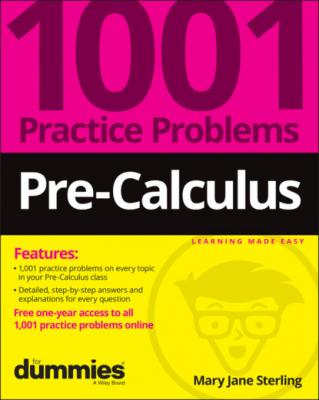Pre-Calculus: 1001 Practice Problems For Dummies (+ Free Online Practice). Mary Jane Sterling
Читать онлайн.| Название | Pre-Calculus: 1001 Practice Problems For Dummies (+ Free Online Practice) |
|---|---|
| Автор произведения | Mary Jane Sterling |
| Жанр | Математика |
| Серия | |
| Издательство | Математика |
| Год выпуска | 0 |
| isbn | 9781119883647 |
368.
369.
370.
371.
372.
373.
374.
375.
Applying Function Transformations to Log Functions
376–380 Find the best choice for a function rule of the transformation of
376.
Illustration by Thomson Digital
(A)
(B)
(C)
(D)
(E)
377.
Illustration by Thomson Digital
(A)
(B)
(C)
(D)
(E)
378.
Illustration by Thomson Digital
(A)
(B)
(C)
(D)
(E)
379.
Illustration by Thomson Digital
(A)
(B)
(C)
(D)
(E)
380.
Illustration by Thomson Digital
(A)
(B)
(C)
(D)
(E)
Applying Logarithms to Everyday Life
381–390 Use the given formula and properties of logarithms to answer the question.
381. Orange juice has a hydrogen ion concentration of 0.001 moles/liter. What is the pH of orange juice? Use the pH formula
382. Ammonia water has a pH of 11.6. What is its hydrogen ion concentration (in moles/liter)? Use the pH formula
383. You invest $5,000 in an account at an annual rate of 1.475% with interest compounding quarterly. Find out how much is in the account (to the nearest cent) after 3 years by using the compound interest formula
384. If you invest $1,000 at a rate of 3.25%, compounded continuously, how many years would it take for your money to double? Round to the nearest hundredth of a year. Use the continuous compound interest formula
385.
